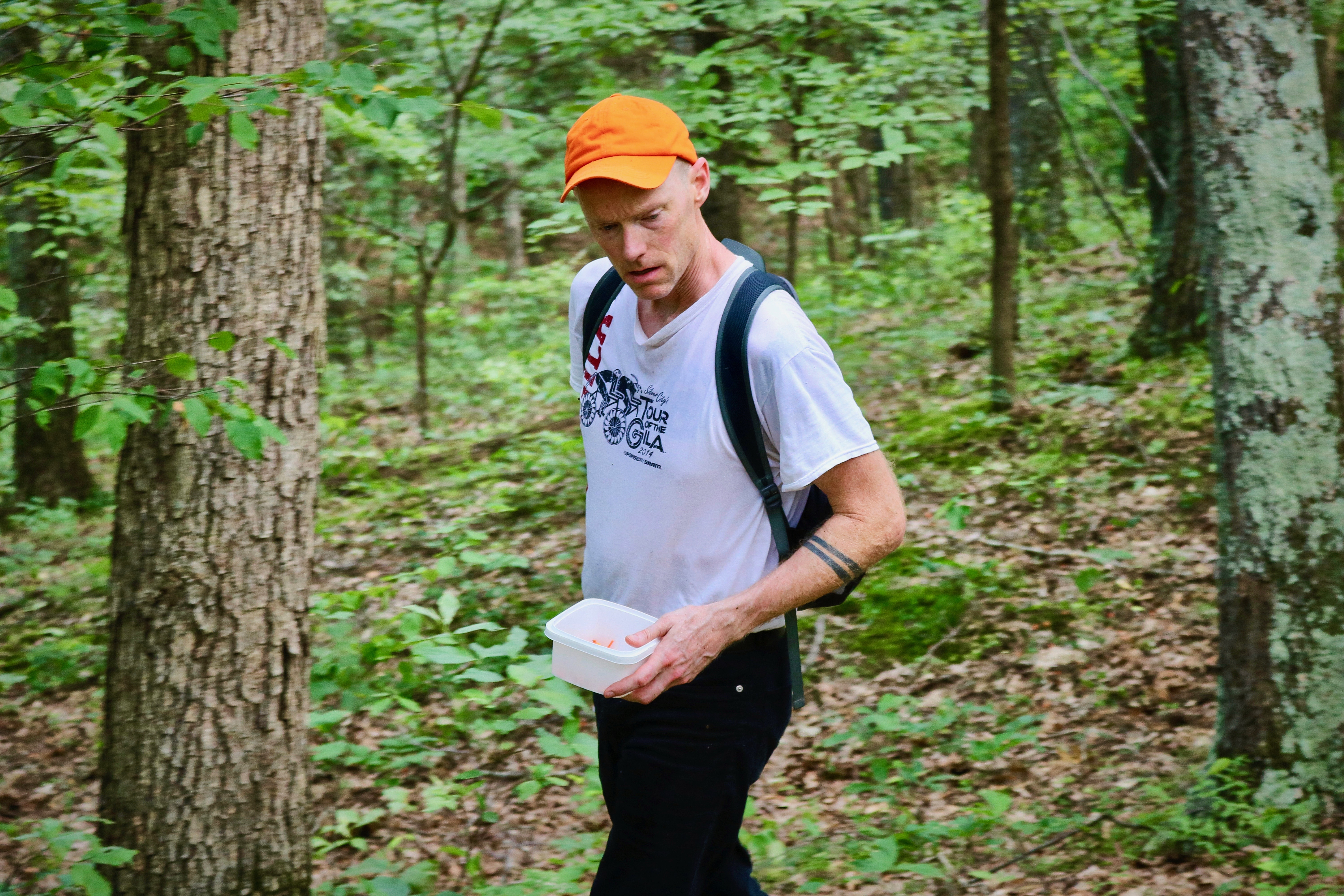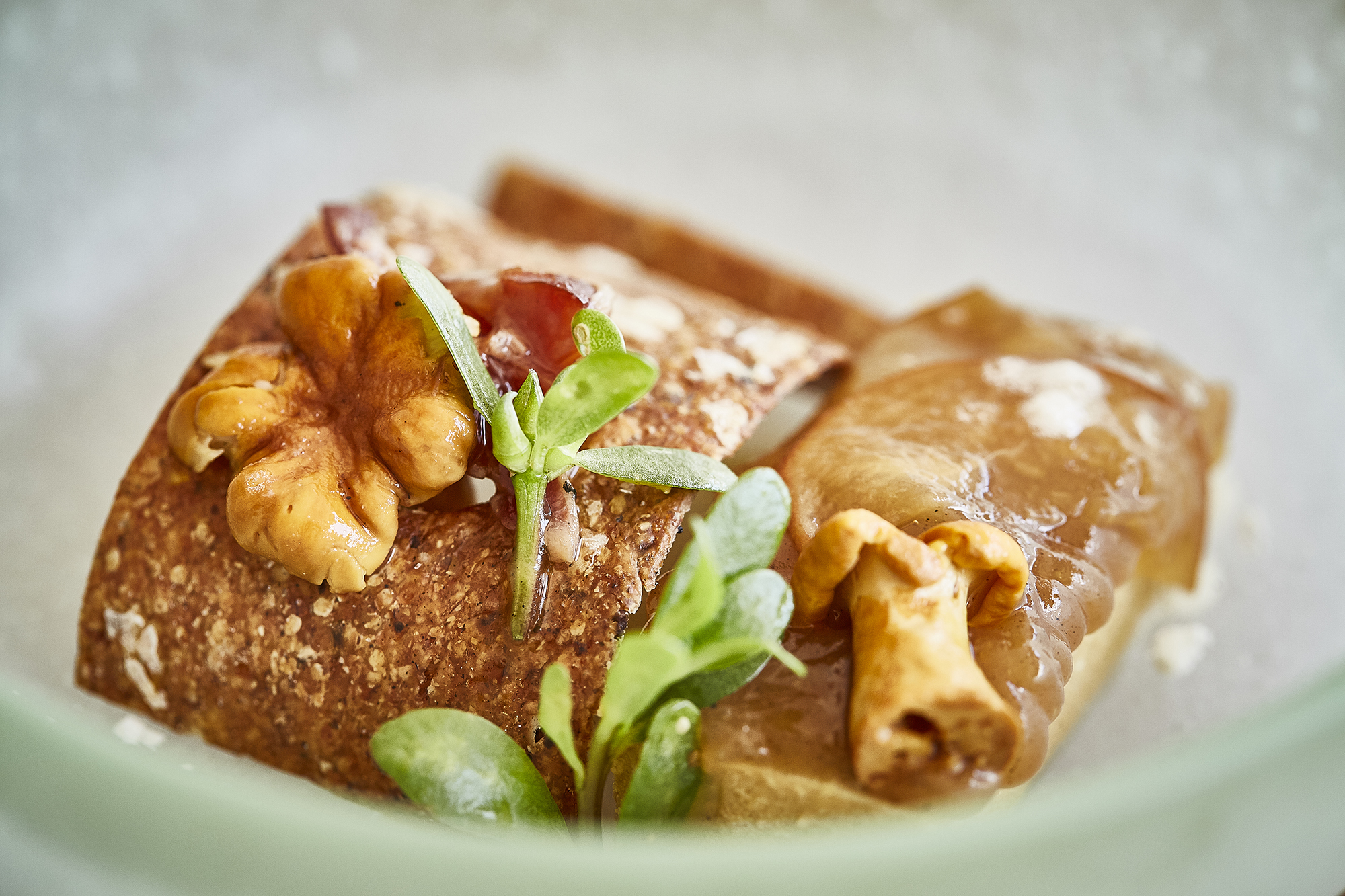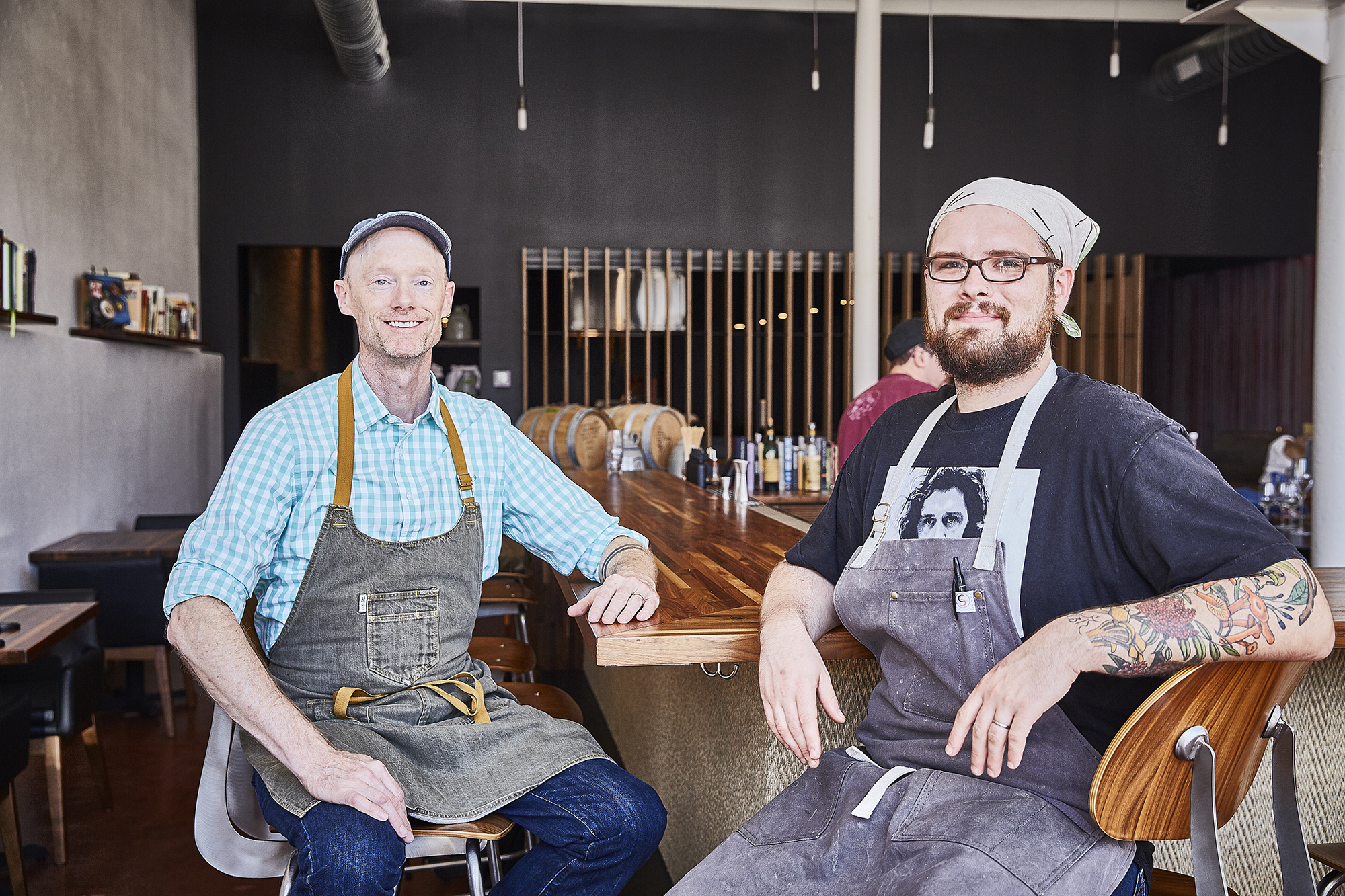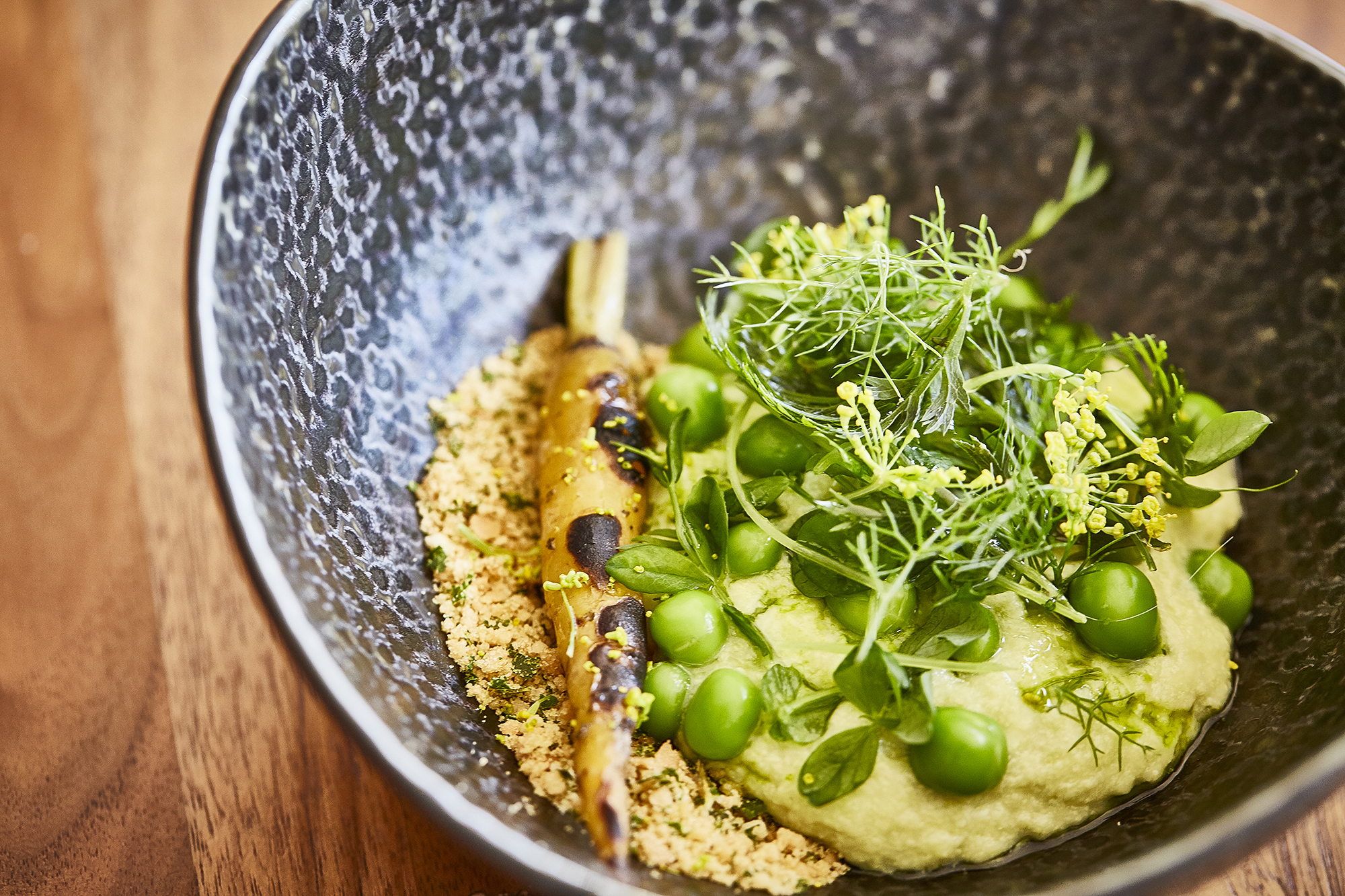Rob Connoley is taking a breather while waiting for me to catch up.
“You good, amigo?” he asks. “We’re on the final stretch.”
I give him two thumbs up, because my body isn’t capable of producing words at this point. We’re in rural Missouri, near the tail end of a forage for cinnabar chanterelle mushrooms to bring to his Ozark cuisine-inspired restaurant Bulrush, which opened in St. Louis this April, and the route we’re on has taken us through shoulder-high grass; thorny, heavily concentrated brush; intense inclines and declines; and slippery puddles of mud.
The trek to the clearing where the chanterelles are is only a mile, but it feels infinite as I struggle to keep pace. A few nights ago, while showing me his impressive library of old Ozark cookbooks, Rob warned me that it would be rough. “There’ll be tick nests and spider webs, and the terrain is like this,” he said, putting his hand in an almost vertical position. I had thought he was kidding.
Connoley is tall and athletic, perfectly attuned for this activity from foraging at least once a week for the past 15 years. In his pre-foraging days, Connoley completed a PhD in sports psychology and followed it up with a decade of social work and grant-writing, eventually landing in Silver City, New Mexico in the early aughts. There, he decided to switch gears and enter the food industry, opening Curious Kumquat, a desert-side restaurant that began as a fast-casual lunch destination for the business crowd, but transformed into a foraged-food hotspot that would earn him a James Beard semi-finalist nomination in the Best Chef: Southwest category. “The soup, salad, sandwich thing got boring really quickly,” he says. So instead of reconceptualizing, he took the menu deeper, finding a way forward by looking into the history of the peoples who had inhabited the land before him.
“There were so few farmers, because we were in the high desert,” Connoley tells me. “There were a few ranchers, a few farmers, but I couldn’t get much stuff… so that led me to the foraging.” Connoley began surveying archaeological research, finding texts about the plants and proteins that had been bountiful in that region. He studied the habits of the Apache tribes of New Mexico, which taught him a lot about finding the strengths and weaknesses of a terrain.

"It’s not like other tribes that were constantly moving all over the place,” he says. “They were there year-round. So, if they were there year-round, what were they eating?”
Working with a foraging mentor, Connoley explored the land, revisiting the same outdoor spaces in each of the four seasons in order to understand how the food options of a territory can change in the course of 12 months. “I could see what cholla looks like in January versus June. I could see what mullein looks like in March versus December, which was really great,” he explains. Before long, he was serving dinners that featured beef short rib, cooked in homemade rye beer and sorghum; local rabbit in a prickly pear ancho sauce; and acorn croquettes with cattail ash.
In 2016, Connoley decided that it was time to move back to his home state, so he left Curious Kumquat and the spicy food and arid land of Silver City for St. Louis, which is located on the eastern edge of Missouri, right off the Mississippi River and just north of the hills and forests of the Ozark Plateau. Now, at Bulrush, Connoley is trying to provide an authentic snapshot of Ozark cuisine, but one that incorporates what we know about cooking in the 21st century.
“We’ve all grown up in the age of Food Network. We’ve got infinite recipes on the internet,” he says. “You want to cook some Bangaladeshi food? Bangaladeshi recipes—there you go. We’re all able to be chefs at this point.” But Connoley wants to do something local, and for Ozark cuisine, that can’t be done with an internet recipe and a trip to the international grocery store. No, these ingredients need to be sought out.
During the forage, my jeans are tucked into my socks, whose heavy wool is at odds with the incredible humidity and heat; the sun isn’t so bad where we are, in the middle of a forest an hour southwest of the city, but the humidity is horrible. I’ve already sweat through my shirt and jeans, which are also covered in permethrin, Connoley’s tick-repellent of choice. The hardship is worth it, though, knowing that we’re here for a purpose—in this case, fungi.
I try to keep this in mind as I carefully hew hundreds of orange mushrooms with my Buck pocket knife. Every so often, when I glance into the plastic box that’s slowly filling up with the fruits of my labor, I feel a palpable sense of pride, the feeling that I’m actually doing some real, meaningful work. At one point in the forage, I ask Connoley what he’s going to do with the chanterelles. He has no idea—only that Justin Bell, Bulrush’s sous chef, would use some in a dish, and that Chris Voll, the bar manager, might do something with them in a drink. He doesn’t know.
He also couldn’t tell me the year he opened Curious Kumquat, but somehow remembered that he first tried quinoa in southern Colorado in early 1995. This is how his mind works.

Weirdly, memory is a huge component of Bulrush—many St. Louisans grew up going to the Ozarks and eating more pedestrian versions of what Connoley’s interested in, like vinegary barbecue, grits, and sweet dishes full of berries and fruits. Many families still go there; mine has had a house at the Lake of the Ozarks since the 1950s, and Connoley’s family has had a cabin out at the eastern edge of the Ozarks proper, near Ste. Genevieve, since the 30s.
“I’m trying to evoke some food memory,” he explains. “Flavor, smell, texture.” It makes sense to me when I eventually taste what Bell has decided to do with the chanterelles: He pickled them to serve with a smoked ham hock terrine, grilled peach gelée, and a cracker made from local hard red wheat and honey-mushroom powder. When I later tell Connoley that the dish reminded me of the comfort food of my childhood, of eating slices of ham and cheese on crackers, he laughs.
“That’s funny,” he says. “Because I said to Justin that it’s like the canned, chopped ham we ate when we were poor…. If [the memory] isn’t there, then we’re off somewhere.” This idea threads the menu together.
In the first course of his tasting menu, I was served yogurt ice cream and pickled strawberry with a cherry amazake sphere that exploded when I bit into it. Another course saw carrots cooked sous vide with sassafras butter alongside an English pea mousse seasoned with ramp oil and shio koji. Later, luscious grilled summer squash came resting on salty, fermented wheat berries; then, an acorn donut and a pickled turnip arrived floating in a sea of white chocolate and potato mousse.
At Bulrush’s bar, which has a separate menu, I recently had a plate of roasted seasonal vegetables served on a corn pancake with whipped sorghum butter, sorrel pesto, and caramelized onions. I enjoyed venison at the bar, served with radish kimchi and black walnut barbecue sauce, but the other people I dined with preferred the turkey thigh with molé turkey confit, chow chow, and cherry chutney.
When talking about his menu—which changes weekly and sometimes daily, depending on the product of his forages—Connoley is precise in his goal: He’s starting from Ozark cuisine as it existed from 1820 to 1870. These dates are not arbitrary, but decided by the years of research, indexing, and even first-hand interviews that Connoley did to prepare for this restaurant. His focus is bracketed by 1820 because that year represents the oldest documented accounts of Ozark cuisine; he chose 1870 because once the Industrial Revolution changed the face of mass communication, transportation, and the dissemination of information, the Ozarks were infiltrated by outside ideas. “Written word and oral tradition is tainted at that point,” Connoley explains. “All of a sudden, I’m seeing Jell-O salad and casseroles in these accounts.” You won’t find those dishes at Bulrush… but you can absolutely sip a Busch beer at the bar while enjoying fried venison bologna sliders.
Outside of the parameters set by Connoley in his research, it’s difficult to get to the center of what authentic Ozark cuisine is. One can look at a map to find a demarcation of the region, the 47,000 miles of hilly, green land that cover northwest Arkansas, southern Missouri, southeastern Kansas, and eastern Oklahoma. There are plants and game specific to the area, foods that have been part of foraging and hunting culture for many years: yarrow, black walnut, salsify, turkey, deer. Connoley is ecstatic about the possibility of getting access to American Chinquapin chestnuts in the near future.

But the question that he’s only started to ask—not what, but when is the Ozarks?—has only brought more questions. Through his work, he’s met academics like Dr. Natalie G. Mueller, who specializes in historical ecology at Washington University. Dr. Mueller’s work involves mapping ancient agricultural systems and the crops they yielded up to almost 9,000 years ago, which is classified as the Middle Archaic Period. Connoley believes that she could actually recreate some of those bygone seeds for harvest, and that those new crops could potentially unveil completely new texture
s and flavors for food. A more thorough knowledge of what Ozark cuisine could have entailed before the modern era might ostensibly give us a deeper understanding of what’s at stake in the food of that region today, and that’s exciting.
Despite his interest in this wing of science—one that seems like it comes from a dystopian sci-fi film or a farmer’s reimagining of Jurassic Park—Connoley is mindful of maintaining nature’s balance. He has great stories from the old foraging days about navigating the sometimes opaque line between regular and endangered species, native and invasive plants and animals. And through thinking about the history of the Ozarks, Connoley has started to understand that the plant species we see as invasive or native may actually be flipped from another point in history, that those we see as native now might have been invasive thousands of years ago. That’s how change works—it’s the dialectic of an environment over long periods of time.
Rob Connoley is keeping the spirit of the Ozarks alive, but his is not the Ozarks we see in TV and film, the drug-dealing hillbillies of Winter’s Bone and Netflix’s Ozark, the dark mysteries of True Detective. While that world is real in its own right, including the social and economic hardships most seen in stereotypes about the region and its people, Connoley represents a different side of its culture. Connoley is a pioneer, an American man who can hike through miles of difficult terrain, survey a patch of land within it, understand what’s there, and employ innovative techniques to transform it into something not only edible, but beautiful. That’s a different kind of grit than the depictions of regional violence and evil we’ve seen on screen in recent years, and one that holds a different kind of promise.
Connoley’s vision of the Ozarks isn’t about destruction, but change and creation—the true essence of the Ozarks. “Learn what will kill you first,” his New Mexico foraging mentor told him years ago. “And then eat everything.” Connoley has.

As we make our way through the final stretch of hill on the way to the car, I think about stopping multiple times. An old ankle injury is acting up, and I feel hot and dehydrated. I’m honestly very close to crying. At one point, I’ve fallen so far behind that I have to hoot in order to evoke a sonic beacon from the group. Once we make it back down the hill and out of the green treachery that almost pushed me to my edge, I hear Connoley yell from up ahead: “Almost there! I’m about ten meters from the car!” As I move breathlessly around the last cluster of trees and finally find a car in my line of sight, I realize that I’ve never been so glad to see one in all my life.
Connoley’s menu might aim at a simpler time—one where traditions were recorded, but not contaminated, by the outside world; where cars, trains, and computers couldn’t bring developments to remote parts of the country. But that time has passed. Now, looking back on those times, and the people who lived them, for guidance is what allows Connoley to push his craft into the future.
from VICE https://ift.tt/2ZndGZD
via cheap web hosting
No comments:
Post a Comment